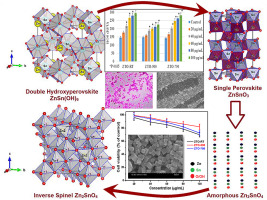当前位置:
X-MOL 学术
›
Mater. Chem. Phys.
›
论文详情
Our official English website, www.x-mol.net, welcomes your
feedback! (Note: you will need to create a separate account there.)
Synthesis of crystalline zinc hydroxystannate and its thermally driven amorphization and recrystallization into zinc orthostannate and their phase-dependent cytotoxicity evaluation
Materials Chemistry and Physics ( IF 4.3 ) Pub Date : 2020-07-01 , DOI: 10.1016/j.matchemphys.2020.122946 Gowra Raghupathy Dillip , Patnamsetty Chidanandha Nagajyothi , Rajavaram Ramaraghavulu , Arghya Narayan Banerjee , Bandugula Venkata Reddy , Sang Woo Joo
Materials Chemistry and Physics ( IF 4.3 ) Pub Date : 2020-07-01 , DOI: 10.1016/j.matchemphys.2020.122946 Gowra Raghupathy Dillip , Patnamsetty Chidanandha Nagajyothi , Rajavaram Ramaraghavulu , Arghya Narayan Banerjee , Bandugula Venkata Reddy , Sang Woo Joo

|
Abstract Engineered metal-oxide nanoparticles have greatly been used in various bio-applications, but their physicochemical properties change dramatically within a bio-system. Therefore, the development of new metal-oxide nanoparticles and proper understanding of their toxicity profile in bio-environment are very important for advancement of cancer-related diagnostic and therapeutic approaches. Nanostructured wide-bandgap semiconductors ZnSn(OH)6 and Zn2SnO4 are fabricated by one-pot hydrothermal synthesis and tested for the first time in anti-cancer treatments. The crystalline zinc-hydroxystannate is converted by high-temperature annealing into amorphous and then crystalline zinc-orthostannate, as confirmed by Rietveld refinement analyses. A dose-dependent cytotoxicity is observed when human cervical carcinoma cell lines are exposed to these nanomaterials, mainly due to the elevation of intracellular reactive-oxygen-species levels in the treated cells, which leads to oxidative stress and cell damage. The crystalline phases of the nanomaterials reveal better cell-killing efficacy due to the overlap of the conduction-band energy levels with the cellular redox potential, leading to favorable electron transfer from the biological redox couples to the conduction-band of the semiconductor nanoparticles, thus producing more reactive-oxygen-species for cell damage. Importantly, this higher reactive-oxygen-species production by the crystalline samples significantly reduces cancer cell migration and proliferation and decreases metastasis, which remains an unmet challenge in cancer therapy.
中文翻译:

结晶羟基锡酸锌的合成及其热驱动非晶化和重结晶成原锡酸锌及其相依赖性细胞毒性评价
摘要 工程金属氧化物纳米粒子已广泛用于各种生物应用,但它们的物理化学性质在生物系统中发生了巨大变化。因此,开发新的金属氧化物纳米粒子并正确理解它们在生物环境中的毒性特征对于癌症相关诊断和治疗方法的进步非常重要。纳米结构的宽带隙半导体 ZnSn(OH)6 和 Zn2SnO4 是通过一锅水热合成制造的,并首次在抗癌治疗中进行了测试。Rietveld 精修分析证实,结晶羟基锡酸锌通过高温退火转化为无定形,然后转化为结晶原锡酸锌。当人宫颈癌细胞系暴露于这些纳米材料时,会观察到剂量依赖性的细胞毒性,这主要是由于处理细胞中细胞内活性氧水平的升高,导致氧化应激和细胞损伤。由于导带能级与细胞氧化还原电位的重叠,纳米材料的结晶相显示出更好的细胞杀伤效果,导致有利的电子从生物氧化还原对转移到半导体纳米粒子的导带,因此为细胞损伤产生更多的活性氧。重要的是,结晶样品产生的这种更高的活性氧物质显着减少了癌细胞的迁移和增殖,并减少了转移,这仍然是癌症治疗中未解决的挑战。
更新日期:2020-07-01
中文翻译:

结晶羟基锡酸锌的合成及其热驱动非晶化和重结晶成原锡酸锌及其相依赖性细胞毒性评价
摘要 工程金属氧化物纳米粒子已广泛用于各种生物应用,但它们的物理化学性质在生物系统中发生了巨大变化。因此,开发新的金属氧化物纳米粒子并正确理解它们在生物环境中的毒性特征对于癌症相关诊断和治疗方法的进步非常重要。纳米结构的宽带隙半导体 ZnSn(OH)6 和 Zn2SnO4 是通过一锅水热合成制造的,并首次在抗癌治疗中进行了测试。Rietveld 精修分析证实,结晶羟基锡酸锌通过高温退火转化为无定形,然后转化为结晶原锡酸锌。当人宫颈癌细胞系暴露于这些纳米材料时,会观察到剂量依赖性的细胞毒性,这主要是由于处理细胞中细胞内活性氧水平的升高,导致氧化应激和细胞损伤。由于导带能级与细胞氧化还原电位的重叠,纳米材料的结晶相显示出更好的细胞杀伤效果,导致有利的电子从生物氧化还原对转移到半导体纳米粒子的导带,因此为细胞损伤产生更多的活性氧。重要的是,结晶样品产生的这种更高的活性氧物质显着减少了癌细胞的迁移和增殖,并减少了转移,这仍然是癌症治疗中未解决的挑战。









































 京公网安备 11010802027423号
京公网安备 11010802027423号